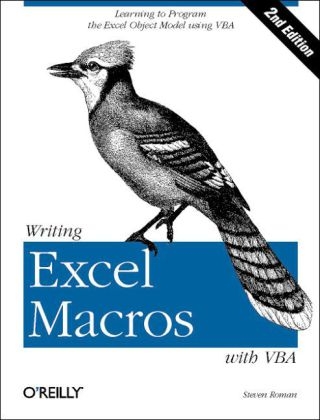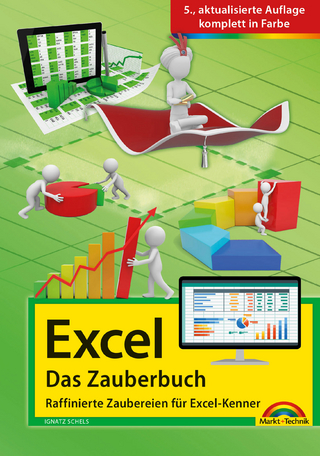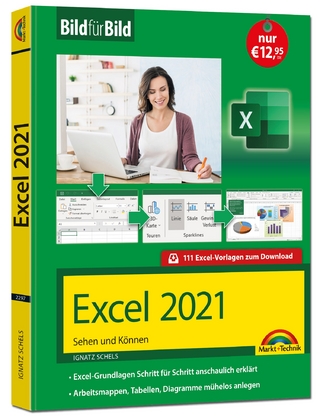
Writing Excel Macros with VBA
O'Reilly Media (Verlag)
978-0-596-00359-3 (ISBN)
Steven Roman is a professor emeritus of mathematics at the California State University, Fullerton. His previous books with O'Reilly include Access Database Design and Programming, Writing Excel Macros, and Win32 API Programming with Visual Basic.
Preface 1. Introduction Selecting Special Cells Setting a Chart's Data Point Labels Topics in Learning Excel Programming Part I. The VBA Environment 2. Preliminaries What Is a Programming Language? Programming Style 3. The Visual Basic Editor, Part I The Project Window The Properties Window The Code Window The Immediate Window Arranging Windows 4. The Visual Basic Editor, Part II Navigating the IDE Getting Help Creating a Procedure Run Time, Design Time, and Break Mode Errors Debugging Macros Part II. The VBA Programming Language 5. Variables, Data Types, and Constants Comments Line Continuation Constants Variables and Data Types VBA Operators 6. Functions and Subroutines Calling Functions Calling Subroutines Parameters and Arguments Exiting a Procedure Public and Private Procedures Project References 7. Built-in Functions and Statements The MsgBox Function The InputBox Function VBA String Functions Miscellaneous Functions and Statements Handling Errors in Code 8. Control Statements The If-Then Statement The For Loop The For Each Loop The Do Loop The Select Case Statement A Final Note on VBA Part III. Excel Applications and the Excel Object Model 9. Object Models Objects, Properties, and Methods Collection Objects Object Model Hierarchies Object Model Syntax Object Variables 10. Excel Applications Providing Access to an Application's Features Where to Store an Application An Example Add-In 11. Excel Events The EnableEvents Property Events and the Excel Object Model Accessing an Event Procedure Worksheet Events WorkBook Events Chart Events Application Events QueryTable Refresh Events 12. Custom Menus and Toolbars Menus and Toolbars: An Overview The CommandBars Collection Creating a New Menu Bar or Toolbar Command-Bar Controls Built-in Command-Bar-Control IDs Example: Creating a Menu Example: Creating a Toolbar Example: Adding an Item to an Existing Menu Augmenting the SRXUtils Application 13. Built-In Dialog Boxes The Show Method 14. Custom Dialog Boxes What Is a UserForm Object? Creating a UserForm Object ActiveX Controls Adding UserForm Code Excel's Standard Controls Example: The ActivateSheet Utility ActiveX Controls on Worksheets 15. The Excel Object Model A Perspective on the Excel Object Model Excel Enums The VBA Object Browser 16. The Application Object Properties and Methods of the Application Object Children of the Application Object 17. The Workbook Object The Workbooks Collection The Workbook Object Children of the Workbook Object Example: Sorting Sheets in a Workbook 18. The Worksheet Object Properties and Methods of the Worksheet Object Children of the Worksheet Object Protection in Excel XP Example: Printing Sheets 19. The Range Object The Range Object as a Collection Defining a Range Object Additional Members of the Range Object Children of the Range Object Example: Getting the Used Range Example: Selecting Special Cells 20. Pivot Tables Pivot Tables The PivotTable Wizard The PivotTableWizard Method The PivotTable Object Properties and Methods of the PivotTable Object Children of the PivotTable Object The PivotField Object The PivotCache Object The PivotItem Object PivotCell and PivotItemList Objects Calculated Items and Calculated Fields Example: Printing Pivot Tables 21. The Chart Object Chart Objects and ChartObject Objects Creating a Chart Chart Types Children of the Chart Object The Axes Collection The Axis Object The ChartArea Object The ChartGroup Object The ChartTitle Object The DataTable Object The Floor Object The Legend Object The PageSetup Object The PlotArea Object The Series Object Properties and Methods of the Chart Object Example: Scrolling Through Chart Types Example: Printing Embedded Charts Example: Setting Data Series Labels 22. Smart Tags What Are Smart Tags? SmartTagRecognizer Object SmartTag Object SmartTagAction Object SmartTagOptions Object Part IV. Appendixes A. The Shape Object B. Getting the Installed Printers C. Command Bar Controls D. Face IDs E. Programming Excelfrom Another Application F. High-Level and Low-Level Languages G. New Objects in Excel XP Index
| Erscheint lt. Verlag | 30.7.2002 |
|---|---|
| Reihe/Serie | O'Reilly Ser. |
| Verlagsort | Sebastopol |
| Sprache | englisch |
| Maße | 175 x 235 mm |
| Einbandart | Paperback |
| Themenwelt | Informatik ► Office Programme ► Excel |
| Mathematik / Informatik ► Informatik ► Programmiersprachen / -werkzeuge | |
| ISBN-10 | 0-596-00359-5 / 0596003595 |
| ISBN-13 | 978-0-596-00359-3 / 9780596003593 |
| Zustand | Neuware |
| Informationen gemäß Produktsicherheitsverordnung (GPSR) | |
| Haben Sie eine Frage zum Produkt? |
aus dem Bereich


